Work-Life Balance for CEOs
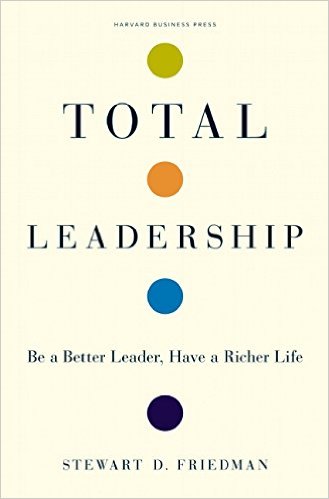 Council member George Forsythe called me last fall. He told me that like most CEOs, he has struggled with work-life balance, trying to fit it everything in, and reacting to everyone else’s needs. He told me how he had found Stew Friedman’s Total Leadership and he started changing his life. George shared that he now enjoys better health, better relationships with family and co-workers, and increased community involvement. George said, “I feel much more in control of how I choose to spend my time.”
Council member George Forsythe called me last fall. He told me that like most CEOs, he has struggled with work-life balance, trying to fit it everything in, and reacting to everyone else’s needs. He told me how he had found Stew Friedman’s Total Leadership and he started changing his life. George shared that he now enjoys better health, better relationships with family and co-workers, and increased community involvement. George said, “I feel much more in control of how I choose to spend my time.”
I happen to know 200 more CEOs who face the same challenges! I got off the phone with George and called Stew. I learned that he did not develop his work in some ivory tower, but in the trenches at Ford Motor Company. Stew now teaches Total Leadership to business students at the Wharton School, where his course is perennially ranked a favorite. And, he takes his life changing work to major corporations all over the globe.
We convinced Stew to offer a one-day workshop for us in Richmond on October 13. We are opening up this workshop to area CEOs and their executive teams. I hope that you will take the time to change your life for the better. You can learn more and sign up here.
Meet Caryn Foster Durham: CEO of Charles Ryan Associates
Caryn Foster Durham firmly believes in making the world a better place. One look at her LinkedIn profile tells you this West Virginia native wants to make a mark on Virginia tourism and economic development, and that she’s a strong advocate for women in business.
As the first in her family to graduate college, Durham’s ultimate goal is to be a role model for her two girls. She wants them to understand that, “You don’t have to play cards you’re dealt; you can often ask for a new hand.”
Twenty-one years ago, Durham began working at marketing firm Charles Ryan Associates (CRA). Management immediately took her under their wing, intentionally grooming her to take over the business when the time was right. She became a minority owner in 2007, and in 2015, she and business partner Susan Lavenski became sole owners. In 2016, three long-time employees – Matt Isner, Matt Fidler and Alisha Maddox – were added to the partnership team.
“Empowering Yourself”
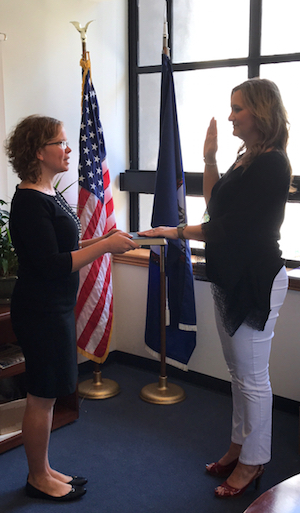 In July of this year, Durham was officially appointed by Secretary of the Commonwealth Kelly Thomasson to the Virginia Council on Women. “I own my business, employ 35 people and do business across many states, so I hope to bring some perspective about business and what’s happening in the contiguous states,” says Durham. “Also, I have access to resources that can help on a larger level through my and association with the National Association of Women Business Owners (NAWBO) as the past president of the Richmond chapter as well as my involvement with the Women Impacting Public Policy (WIPP) and U.S. Women’s Chamber. And I’d love to help Virginia get back to the number one spot on the ‘Best States to Do Business’ list!”
In July of this year, Durham was officially appointed by Secretary of the Commonwealth Kelly Thomasson to the Virginia Council on Women. “I own my business, employ 35 people and do business across many states, so I hope to bring some perspective about business and what’s happening in the contiguous states,” says Durham. “Also, I have access to resources that can help on a larger level through my and association with the National Association of Women Business Owners (NAWBO) as the past president of the Richmond chapter as well as my involvement with the Women Impacting Public Policy (WIPP) and U.S. Women’s Chamber. And I’d love to help Virginia get back to the number one spot on the ‘Best States to Do Business’ list!”
The stated purpose of the Virginia Council on Women is “to identify ways in which women can reach their potential and make their full contribution to society and the Commonwealth.” What are some of the barriers Durham feels are keeping women from reaching their potential? Her answer may surprise you.
“A few months ago, I was asked to keynote a women’s entrepreneurship conference in Virginia Beach,” says Durham. “The speech I chose talked about empowering yourself. We are, in my opinion, our own worst barriers to success. That’s obviously a blanket statement, but, by and large, we hold ourselves back more than anyone else. We doubt ourselves and don’t trust our intuition, for example. And we can be unkind to each other.”
“If we’re going to break that ceiling, we have to bring other women with us, and we need to include men in the conversation, because you can’t change the trajectory of things if you only have one side of the equation,” she continues. “We need to take responsibility for our own path.”
Finding Like Minds in VACEOs
The path Durham chose led her to the Virginia Council of CEOs in 2013. “My roundtable is invaluable to me,” she says. “One reason I wanted to join the Council was that I’d never been a CEO before. I knew how to make money and how to hire – I’d been doing that for years before I became the owner of a business – but I didn’t know how to be a CEO. The best gift my roundtable gave to me was the realization that I do know what I’m doing, I’m doing things right, and the questions I have are the same questions that other CEOs have.”
“My roundtable is invaluable to me” – Caryn Foster Durham, CEO, Charles Ryan Assoc.
The business owners in Durham’s roundtable group represent organizations that are the same size as hers, but they all vary in lifecycle stage and industry. “That has been equally gratifying,” she explains. “I truly feel like they have had a positive impact on my business and have helped me be a better person and CEO. I truly feel like I have helped them, as well.”
Durham says she wants to bring similar peace of mind to other businesswomen and will work actively with the VACEOs team to develop events that will attract this underrepresented market. In fact, you’ll find her co-hosting an event with VACEOs this fall!
Could That Empty Desk Be Your New Competitive Advantage?
If someone proved that you were actually using less than 50% of your office space, what would you do with the empty excess? Well, that next lease could be a LOT smaller, but that might not be an option right now. So, what if you could publish that empty, excess capacity to your customers, partners, prospects, prospective talent, or even to the public and generate revenue from it?
What if you could “Airbnb your office space?”
Airbnb allows us to generate revenue from our empty homes, and Uber allows people to generate revenue from the 92% average “emptiness” of our cars. The exciting news is that your business can now participate in the Sharing Economy. Imagine inviting those with whom you do business into your space, and watching the magic that happens when you collaborate more closely. It’s not hard to imagine the possibilities if you’re a creative, forward-thinking CEO.
What if, as a result of operating your space as a shared resource, your employees became more engaged, productivity increased, and you were doing something beneficial for the environment? All good stuff, right?
This ideal working environment is within our grasp, says Virginia Council of CEOs member, John Vivadelli, President and CEO of AgilQuest.
MONETIZE IT. SHARE IT. IMAGINE IT.
Look around. How many desks and rooms are going unused in your office space? Like it or not, you’re paying for that space. AgilQuest has been measuring business space inefficiency for over 20 years and has uncovered some remarkable figures.
“In the mid-90’s when I started AgilQuest, it was very common to see companies actually using 50%of their space effectively,” says Vivadelli. “Now we’re seeing office spaces and buildings that are 60 to 70 percent vacant. A lot of it has to do with the impact of technology, freeing people to be more mobile and giving them more choices about where and when to go to work. More often than not, work is now done outside of the traditional office, leaving desks and conference rooms empty,” says Vivadelli.
Another reason there’s empty desks? Many small businesses get trapped into long term leases with large amounts of “just in case” space, as in just in case we grow. You’re only using 30 to 40% of your space now, do you think that percentage is going to go up over time? (Cue more empty desks and conference rooms.)
“The future of the workplace should be centered around choice, sharing and monetization,” says Vivadelli. “To take advantage of this concept, measure your office’s efficiency, share and optimize its use, and then either divest of the excess or publish it to others.”
He has the numbers to back up his assertion. One AgilQuest client, located in New York City, shares space at an average of 3 people-to-desk ratio, allowing them to cut its square footage in half resulting in savings of about $100 million a year in real estate expenses. Another client – a government agency – downsized its real estate holdings, converted to a 2-1 worker-to-workspace ratio, and saved more than $24 million.
For CEOs locked into a large space with a hefty lease, the time is right to monetize it, Vivadelli tells us. Share your space, just like people share cars and houses. A win-win for everyone –for those who want to save money, and employees with increasing demands for flexible space.
“Who would’ve thought four years ago that a company would essentially legitimize hitchhiking?” asks Vivadelli. “Think about it: Uber is now a $69 billion company. And who would’ve thought you would share your bed or home with strangers? That’s called Airbnb, and that company is more valuable than any hotel chain. If I’m willing to share my car or my bed, sharing a desk is not as far out there as it used to be.”
“Giving people a choice of where and when to go to work drives engagement,” Vivadelli explains. “Engagement drives productivity. Productivity drives revenue. What our products and services do is give people a choice.”
LIVING THE BRAND
When your value proposition is about space efficiency, what’s does your space look like? The AgilQuest space is just what you would expect. Rooms are available for anyone inside or outside the company to reserve, and the entire bottom floor of the building is set up to demonstrate how a flexible environment can function.
 Everything can be easily moved, and there’s small rooms for huddles, a nice kitchen, and an attractive outdoor space. It’s a place to work during the day; a great event space on the weekend.
Everything can be easily moved, and there’s small rooms for huddles, a nice kitchen, and an attractive outdoor space. It’s a place to work during the day; a great event space on the weekend.
“Wouldn’t it be interesting if we could break down the barriers – the real estate walls we work within – and see if we can get our organizations to interact much more freely with each other,” asks Vivadelli. “And by doing so, instead of thinking of real estate as a cost to be minimized, or a place to stick people in, look at real estate as an asset that can be monetized and used to generate revenue?”
Airbnb for office space. Imagine the possibilities.Interested in learning more? Contact john.vivadelli@agilquest.com.
Business Meets Virtual Reality: What’s In Store?
There’s no denying it. Technology, business applications and “reality” are melding together in exciting and fascinating ways.
The virtual and augmented reality technology of today is helping us create better products and enhanced work experiences. It’s making us better designers, trainers and consumers. It’s even being used in the medical sector to treat phobias and prepare patients for surgery.
Virtual Versus Augmented: What’s the Difference?
“Virtual reality offers a digital re-creation of a real-life setting, while augmented reality delivers virtual elements as an overlay to the real world.” (source: augment.com)
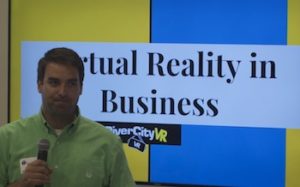 During a recent virtual reality (VR) demonstration to VACEOs membership, Rob Newton of River City VR shared some of his experience with the latest technology. “I’ve seen VR applications in the medical industry that use a full 3-D high-resolution representation of the body, inside and out. Doctors can then practice surgery on the virtual patient. This is not just a generic dummy, but a specific virtual body with all its nuances. It’s pretty amazing!”
During a recent virtual reality (VR) demonstration to VACEOs membership, Rob Newton of River City VR shared some of his experience with the latest technology. “I’ve seen VR applications in the medical industry that use a full 3-D high-resolution representation of the body, inside and out. Doctors can then practice surgery on the virtual patient. This is not just a generic dummy, but a specific virtual body with all its nuances. It’s pretty amazing!”
Companies like Adidas, IKEA and Lowe’s are embracing augmented virtual experiences to create meaningful customer interactions – overlaying product options over customer photos to enhance the buying experience. Law enforcement agencies are using VR to re-create crime scenes and walk police officers through stressful training exercises without risk to their staff or the public, reports Newton.
Imagine, as a business owner, having the ability to train your employees on complex or potentially dangerous procedures with little cost or risk. Or, if you’re like Kevin McNulty, president of LifeStyle Home Builders, imagine avoiding weeks of time delays and labor expenses on home builds while enhancing the customer experience.
McNulty, a VACEOs member, has been rendering traditional 2-D design drawings in a 3-D VR format for about a year.
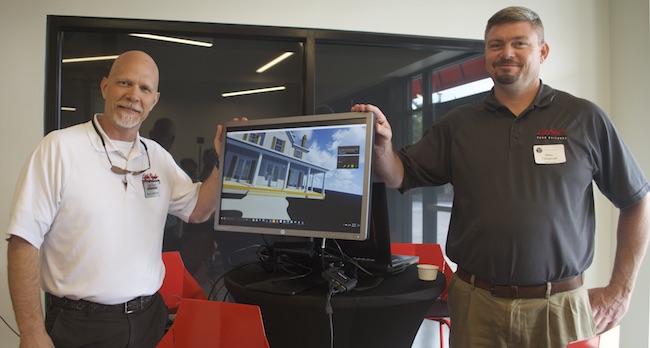
Member Kevin McNulty with Mike Fitzgerald of LifeStyle Home Builders demonstrate their virtual reality application.
Customers gain a great sense of spatial awareness during the virtual walk-through, which can take them wherever they choose to go – from outside the home to any room within – through bathrooms, the kitchen, closets and even the roof. After the tour, they may sometimes wish to alter a window or wall – which isn’t a big deal in the early stages of the game.
“Reaction to the VR system has been extremely positive,” says McNulty.
Manufacturing Leading the Way, Office Applications Next
Many manufacturing companies, like automotive giant Ford, are embracing virtual experiences to streamline equipment training. The reward can be higher employee retention rates, lower safety risks, fewer accidents and advanced training opportunities.
“According to a recent survey, safety manufacturing is the second most popular application of VR and augmented reality among U.S. manufacturers,” said Rob Newton in his presentation to the membership. “Virtual reality offers a unique and powerful conduit for training and safety education.” (Imagine a new employee expertly guiding your $15 million crane the first time they touch the controls after a few VR sessions!)
Why Use VR for Industrial Safety Training?
- Learning by doing, or experiential learning, leads to higher retention rates
- Employees gain experience without risking equipment or safety
- High-end consumer VR equipment sales are driving simulator costs down
- Video game engines are well equipped to create realistic simulations
- Teaching best practices helps prevent accidents in warehouses and on docks
- Workers can be trained in navigating hazardous environments or intensive maneuvers
What’s Next?
Newton reports that in the very near future, VR headsets, phones, glasses and contacts will evolve to become our personal portals into the expanding virtual world. Many of us will begin to participate in Microsoft’s “mixed reality” vision – one in which holographs are used to pin virtual objects to physical spots in space. “Windows is going to push for that, and it’s going to become a natural thing for us to think about virtual reality and augmented reality during our computing day to day,” he says.
In the very near future, he added, some of us will experience virtual collaborations with virtual employees on virtual products.
Is your company embracing VR technology? We’d love to hear about it!
https://www.facebook.com/vaceos/videos/1614356755243159/
Social Media Expert Corey Perlman Shares Strategies
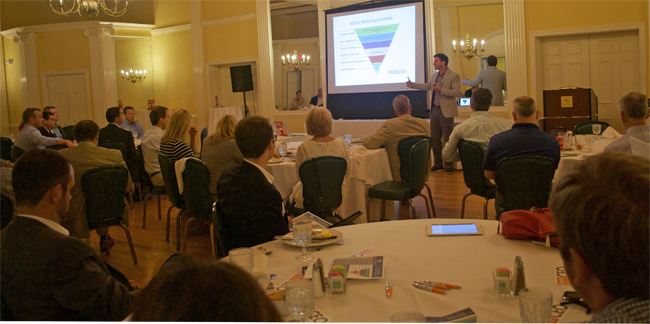 VACEOs members have a thirst for knowledge. They relish Council events that expose them to best-selling authors and wholeheartedly dive into conversations with national thought leaders. They hunger for ways to streamline their operations, engage their employees and market their businesses.
VACEOs members have a thirst for knowledge. They relish Council events that expose them to best-selling authors and wholeheartedly dive into conversations with national thought leaders. They hunger for ways to streamline their operations, engage their employees and market their businesses.
On May 25, members got a chance to hear from Corey Perlman – consultant, nationally recognized social media expert and author of Social Media Overload! His presentation – “Simple Social Media Strategies for Overwhelmed and Time-Deprived Businesses” – could not have been more relevant for his audience.
Perlman challenged us to prioritize our activity on social media platforms – to “buckle down where buyers are” and not be tempted by platforms that don’t make sense for our business. He advised us to create a team or bring in an agency to help with social media instead of trying to do everything ourselves. He also introduced us to a social media sales funnel to guide us through ALL the reasons to participate in social media (it’s NOT all about generating leads), and encouraged us to think outside the box when it comes to content and to be patient for results.
We won’t share everything we learned, but here are five actionable items every CEO of a small or medium-sized business can use to their advantage.
https://www.facebook.com/vaceos/videos/1595840410428127/
FIVE SOCIAL MEDIA ACTION ITEMS FOR EVERY CEO
1. TAKE INVENTORY
Google your business and yourself. What platforms are you on? Don’t forget to check out reviewer sites and personal/company/employee LinkedIn accounts. How’s your brand looking?
2. PRIORITIZE YOUR PLATFORMS
Do you really need to be on Twitter? Maybe not. Not sure where which platforms you should be on? Google the demographics of each and ask your customers. Double down on a few instead of spreading yourself too thin.
3. UPDATE
When was the last time you updated your website? Was it more than three years ago? If so, it’s time to update to current standards. And while you’re at it, update all of your LinkedIn accounts since the design has changed.
4. POST
Post.
Every day.
To LinkedIn.
Post only content that has value.
5. GO LIVE
Challenge your social media team to get on the Facebook Live bandwagon. “You’ll see more activity and engagement on a Live video than you will on any other post you do on Facebook, so I encourage your watchers here to think about how they can go live,” said Perlman.
6. (BONUS) GET PERLMAN’S NEW BOOK, SOCIAL MEDIA OVERLOAD!
Corey Perlman’s latest book is a quick and easy read, packed with actionable items that will give you a firm grasp of the strategies that will work best for your business.
About Corey Perlman
Corey Perlman is an entrepreneur, author and nationally recognized digital marketing expert. He is also the owner of eBoot Camp, Inc. – a team of highly skilled digital marketing specialists who manage social media accounts for more than 40 companies. His latest book, Social Media Overload!, is an Amazon.com bestseller in every major business category. Learn more about Corey Perlman.


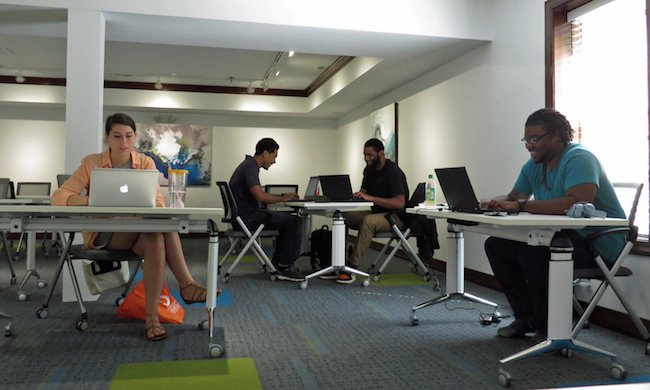
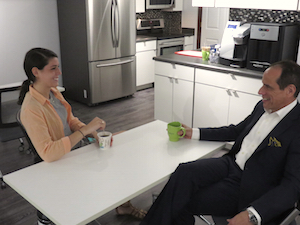
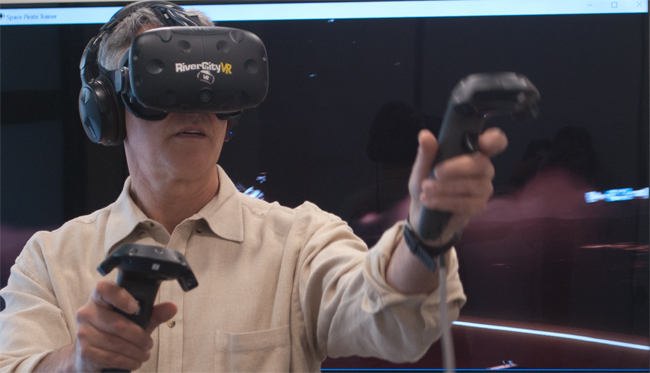
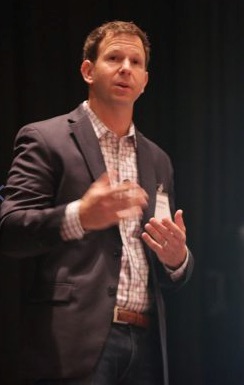
Recent Comments